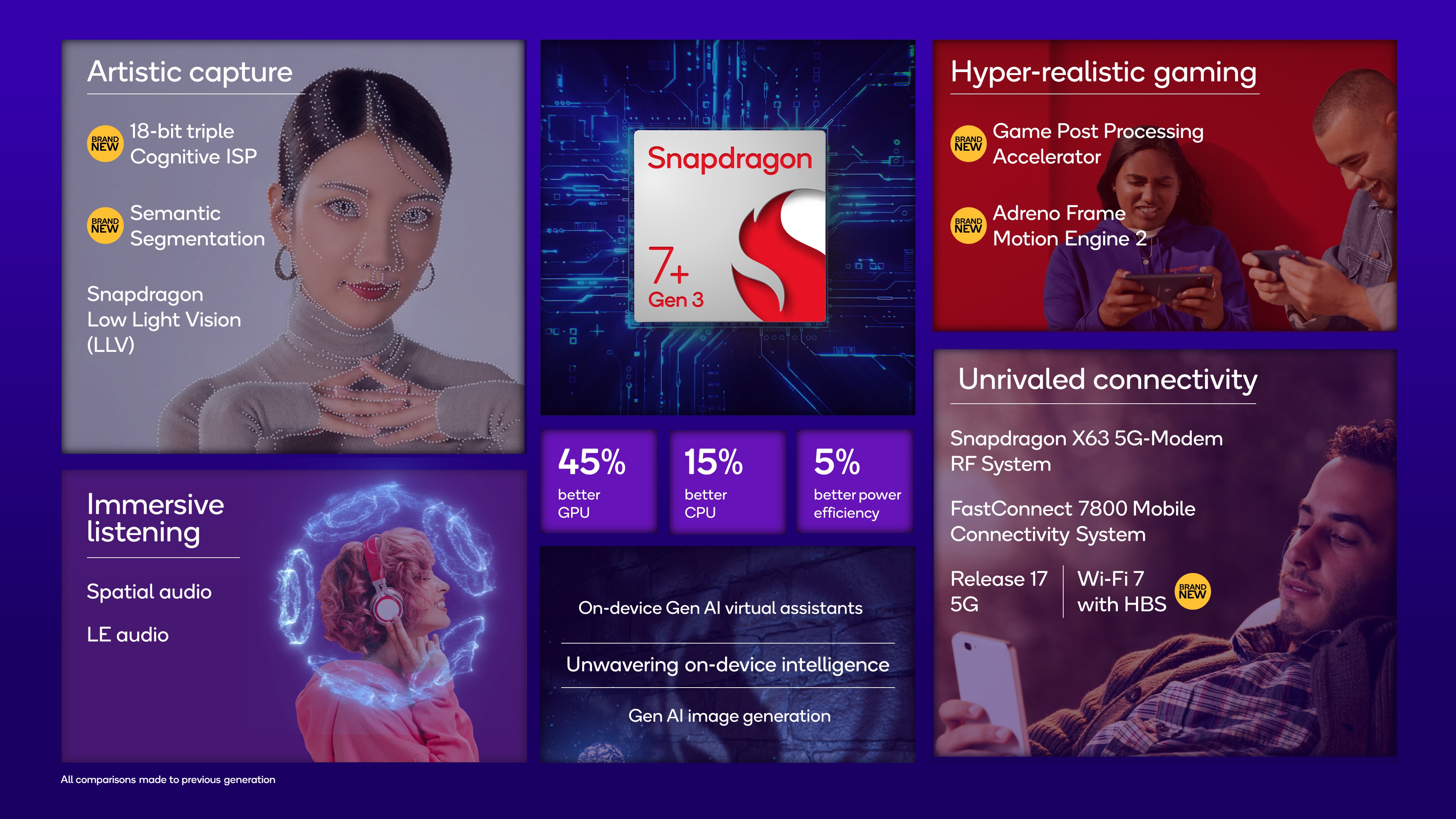 INFRA
INFRA
 INFRA
INFRA
 INFRA
INFRA
Smartphone chipmaker Qualcomm Inc. said today it’s bringing powerful generative artificial intelligence capabilities to midrange handsets with the launch of its latest chipset, the Snapdragon 7+ Gen 3.
The new silicon provides support for generative AI models such as Llama 2, Gemini Nano and Baichuan-7B, meaning the smartphones that run it will be able to power various applications based on those models. Qualcomm also claimed a 15% boost in central processing unit performance and a 45% increase in graphics processing unit performance.
The Qualcomm Snapdragon 7+ Gen 3 processor is aimed at midrange devices, making its debut just days after the company announced a new chip for higher-end smartphones, called the Snapdragon 8s Gen 3.
The Snapdragon 8s Gen 3 takes many of the AI features of Snapdragon’s best chip, the flagship Snapdragon 8 Gen 3, and packages them in a lower-cost system-on-chip for devices in the $800 to $1,000 price ranges. Now, with the Snapdragon 7+ Gen 3, it’s bringing those same AI features further down the pricing ladder.
According to the company, the Snapdragon 7+ Gen 3 is basically an improved version of last year’s Snapdragon 7 Gen 3 chip, with significant increases in processing speed, efficiency and connectivity, plus more on-device generative AI capabilities and enhancements to gaming and artistic photography.
Qualcomm said the new chip runs on an improved Kyro CPU based on a 64-bit architecture, and it has been given a substantial performance bump. For instance, the speed on the single prime core has risen from 2.63 gigahertz on the 7 Gen 3 and 8s Gen 3, to 2.8 gigahertz on the Snapdragon 7+ Gen 3. Whereas the 7 Gen 3 chip had three performance cores at 2.4GHz, the Snapdragon 7+ Gen 3 has four at 2.6 gigahertz. In addition, while its predecessor has four efficiency cores at 1.8 gigahertz, the newer model has four efficiency cores that clock in at 1.9 gigahertz.
This rearrangement and boost in clock speed and core speeds results in a 15% overall improvement in CPU processing performance, as well as a 45% boost in GPU performance and an overall 5% efficiency gain across the entire system, Qualcomm said. The company did not provide benchmark test results to back up those numbers.
In terms of generative AI, the Snapdragon 7+ Gen 3 boasts the same Hexagon neural processing unit and Adreno GPU that’s found in the more powerful Snapdragon 8s Gen 3 chip, which means that it also has the ability to support multiple large language models. In addition, it supports an always-on sensing camera, with INT4 precision and dual-mic NPUs for audio sensing.
Gamers may also be introduced in the Snapdragon 7+ Gen 3, as Qualcomm claims it can support some of the more advanced gaming features found on the 8s Gen 3, including the new Post Processing Accelerator and Adreno Frame Motion Engine 2, which work in tandem to enhance and upscale graphics performance and reduce battery drain. However, the Snapdragon 7+ Gen 3 does not get real-time ray tracing support, so the higher-tier chip will still retain an edge in overall graphics performance.

Qualcomm talked about a new 18-bit cognitive ISP that will enable “artistic capture” functionality. With this, users will have the ability to enhance up to 12 layers of their photos and videos in real-time edits, which is a new feature that was announced on the 8s Gen 3 earlier this week.
The Snapdragon 7+ Gen 3 will also support tools such as Snapdragon Low Light Vision, multi-frame noise reduction and AI-based facial recognition. It will not support 8K resolution video, instead topping out at 4K at 60 frames per second, but it does support pro sight video capture, Bokeh Engine 2 video capture and video super resolution, enabling enhanced videography.
Lastly, Qualcomm talked about the Snapdragon 7+ Gen 3’s connectivity, saying it supports the company’s new 7800 FastConnect system, which bundles Wi-Fi 7, Bluetooth 5.4 Low Energy Audio, Auracas and various codecs, including aptX Adaptive, aptX Lossless and aptX Voice. Other specifications include support for LPDDR5x memory, UFS 4.0 storage, up to 24 gigabytes of random-access memory and enterprise-grade security, the company said.
Qualcomm didn’t announce a specific launch date, but various reports say the new chip will make its debut in a new generation of smartphones from OnePlus USA Corp. before coming to other devices later in the year.
Support our mission to keep content open and free by engaging with theCUBE community. Join theCUBE’s Alumni Trust Network, where technology leaders connect, share intelligence and create opportunities.
Founded by tech visionaries John Furrier and Dave Vellante, SiliconANGLE Media has built a dynamic ecosystem of industry-leading digital media brands that reach 15+ million elite tech professionals. Our new proprietary theCUBE AI Video Cloud is breaking ground in audience interaction, leveraging theCUBEai.com neural network to help technology companies make data-driven decisions and stay at the forefront of industry conversations.